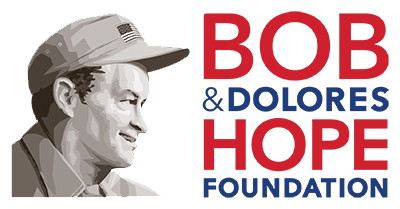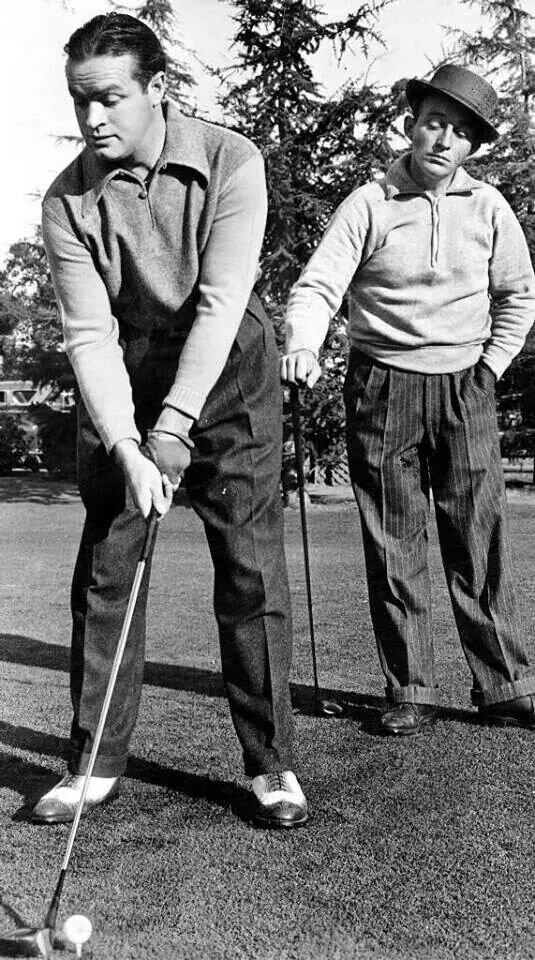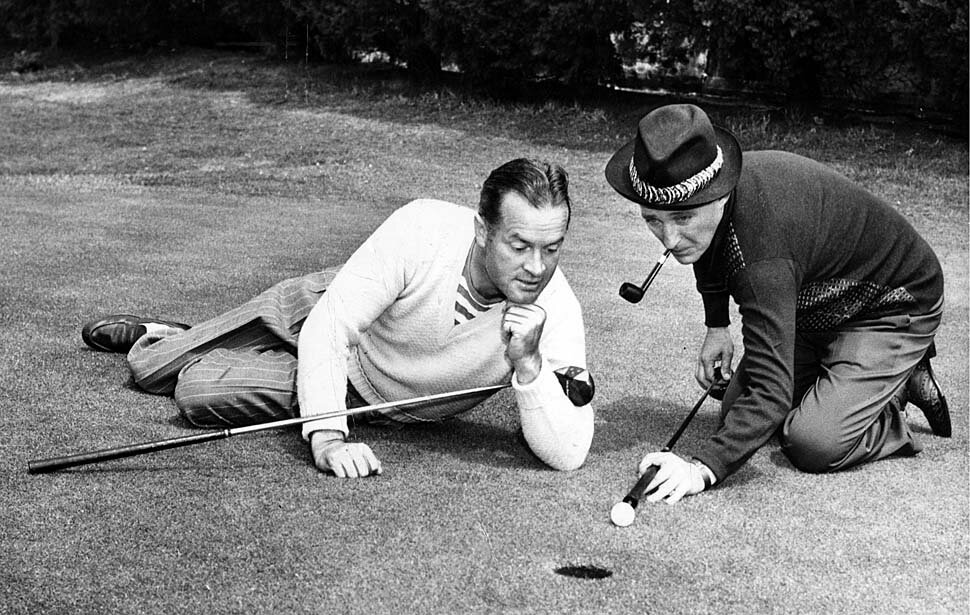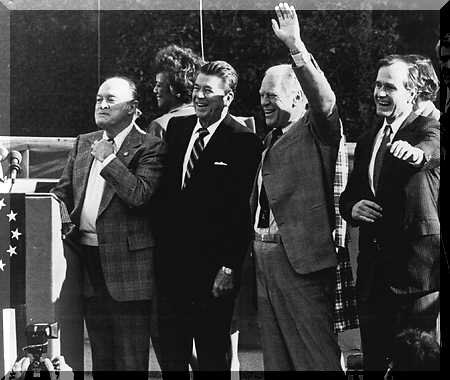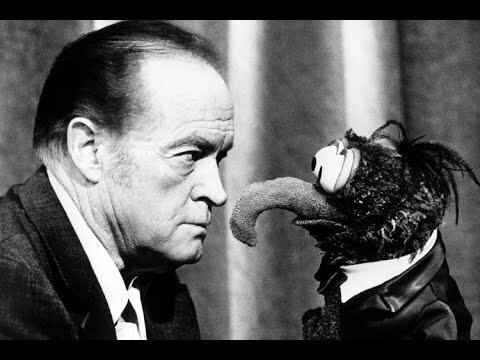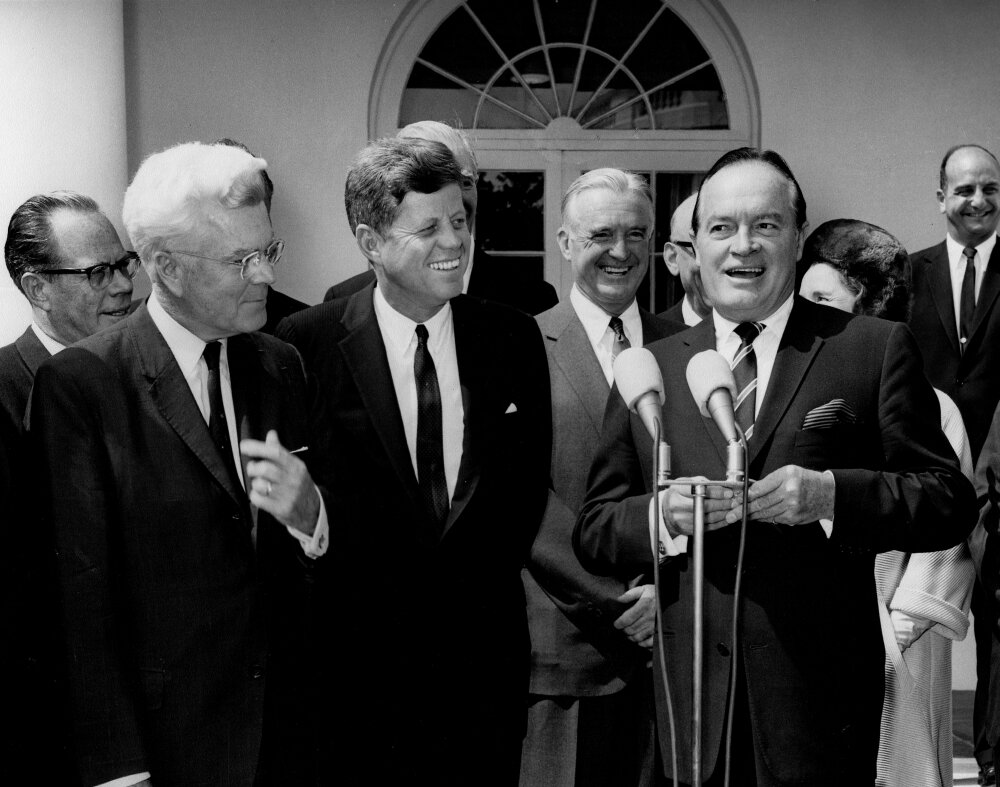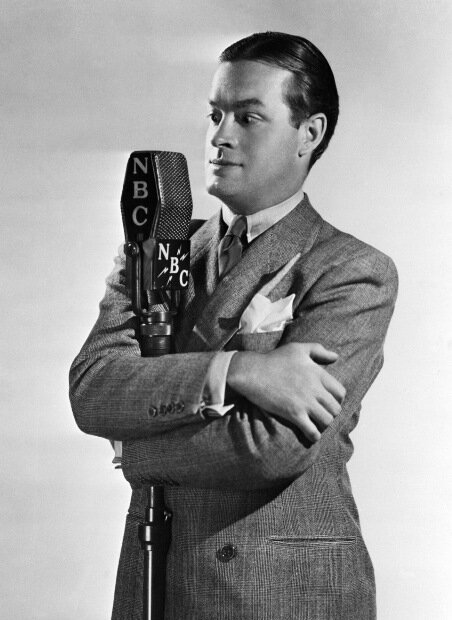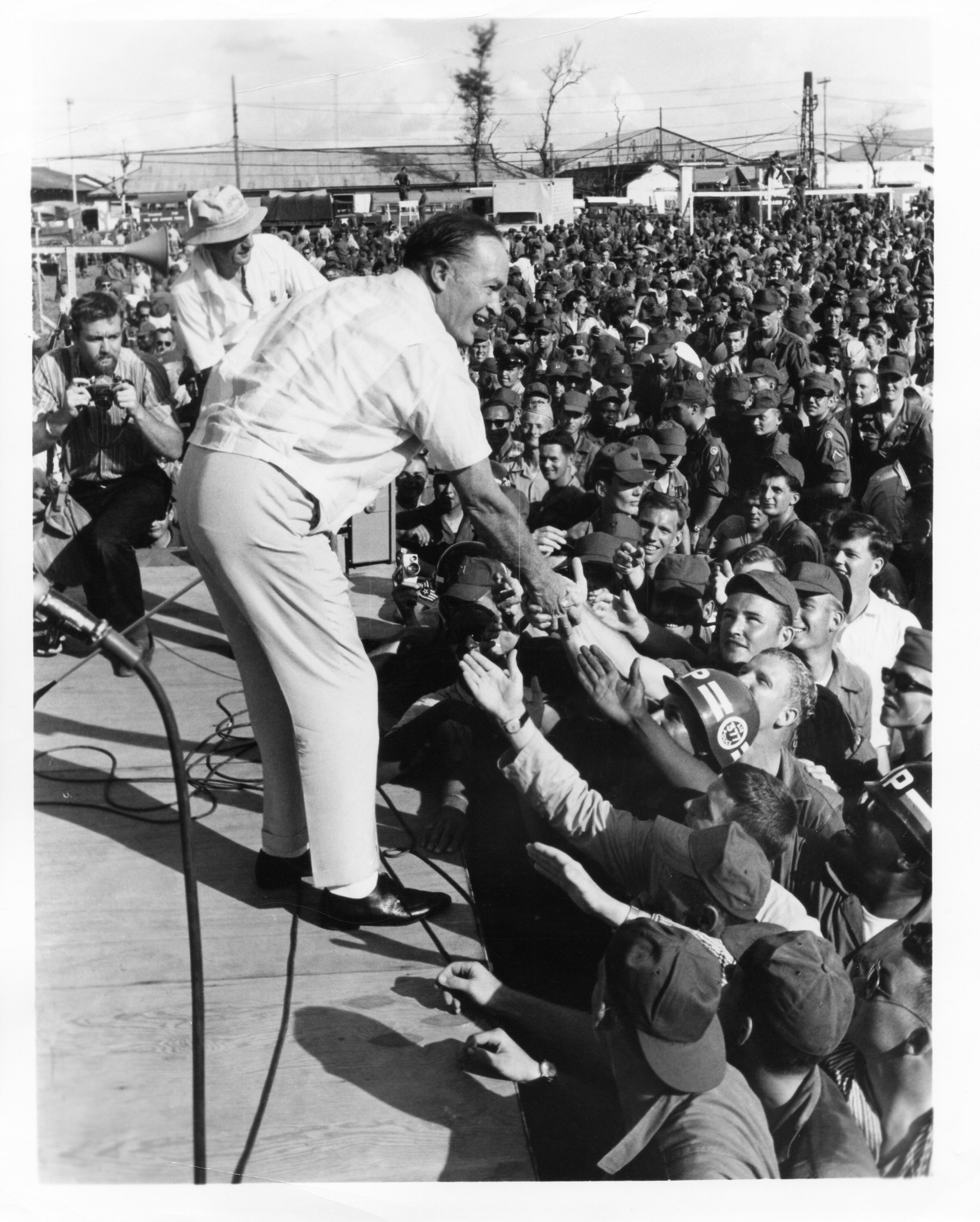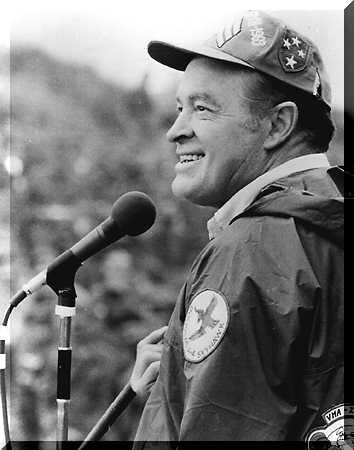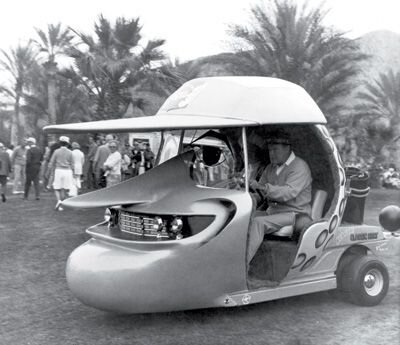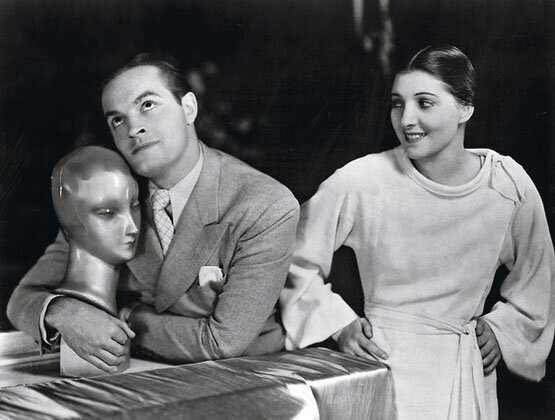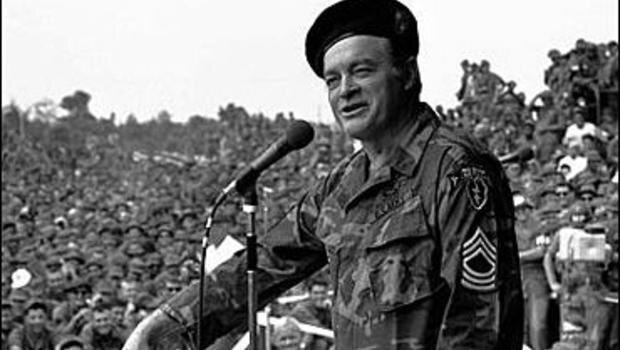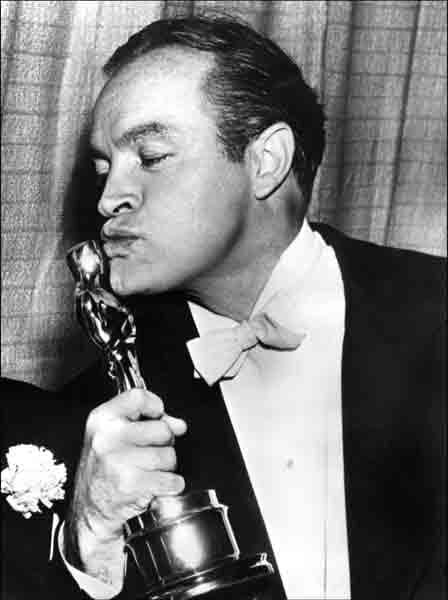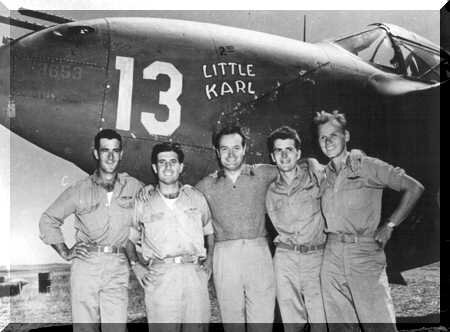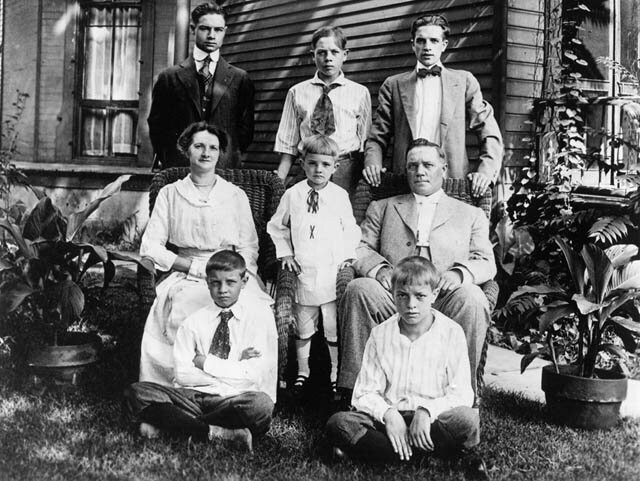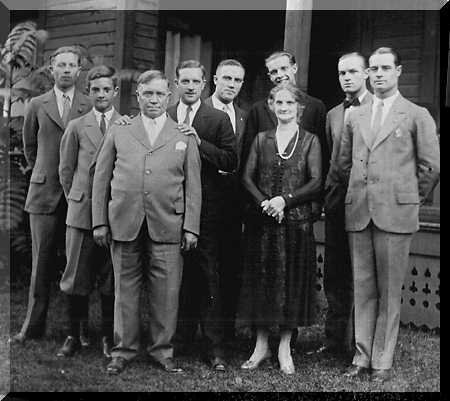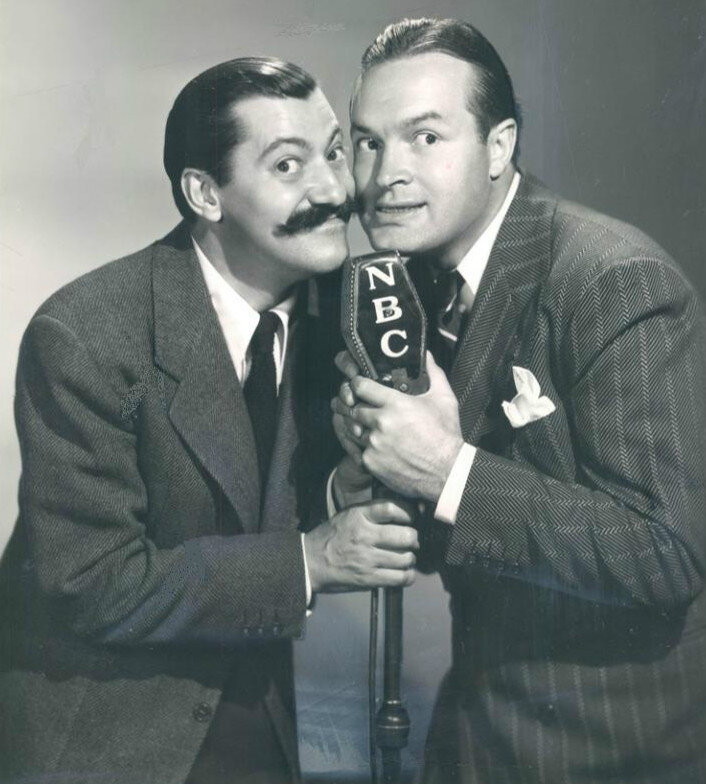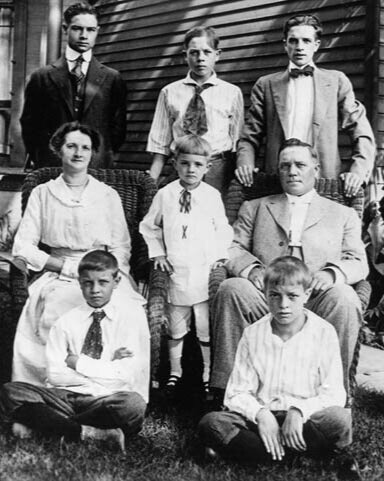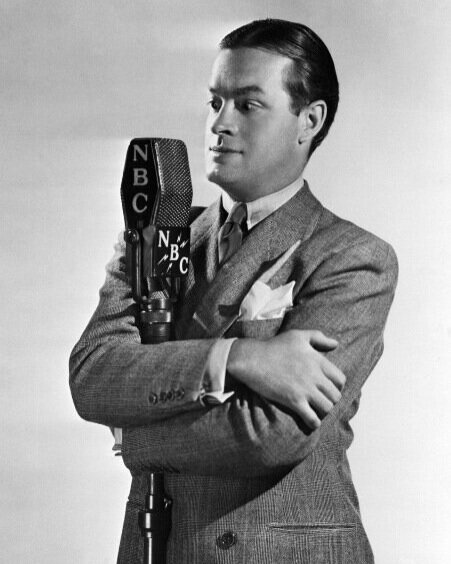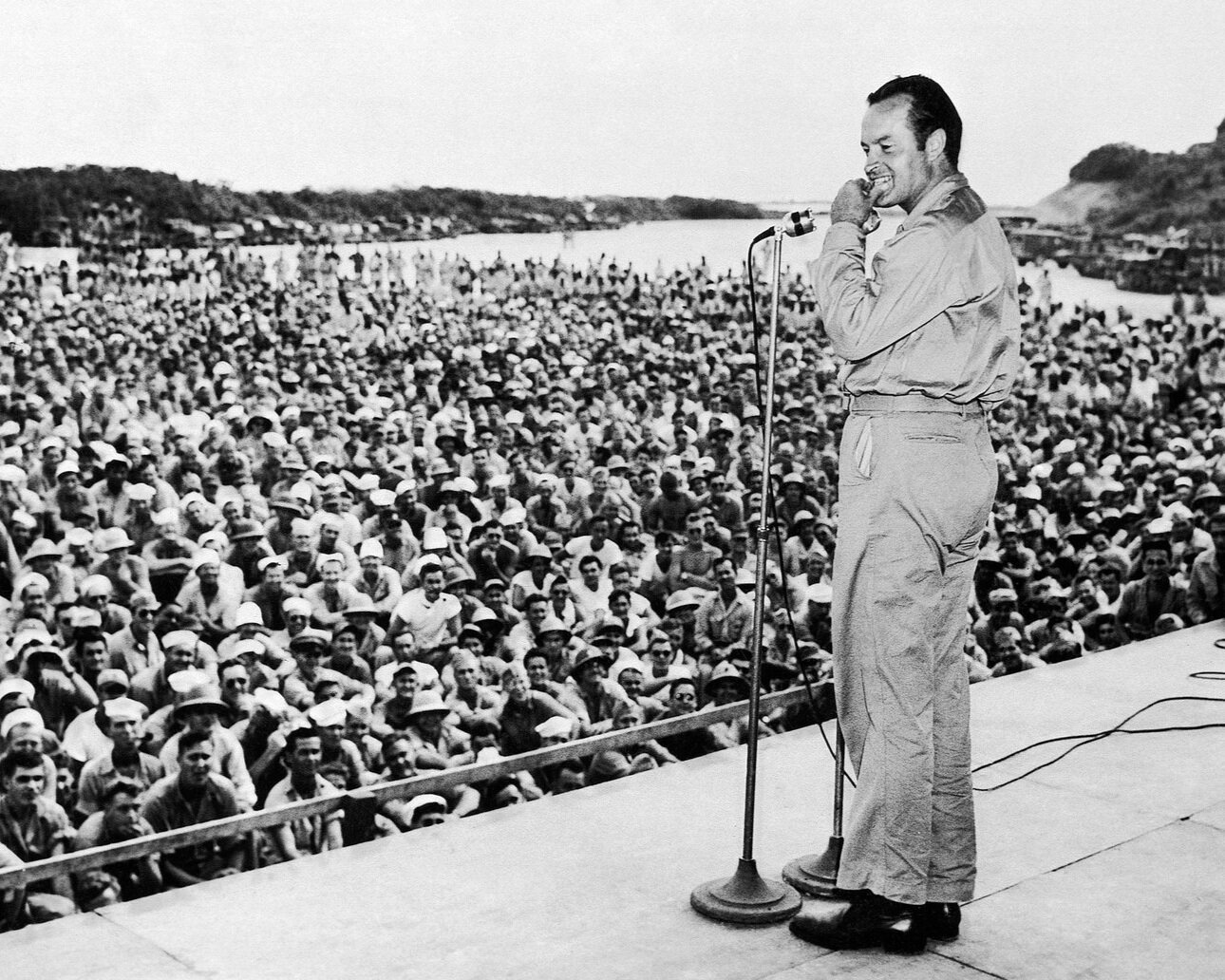BOB HOPE
Beginning | Broadway | radio | movies | television | presidents | troops | golf | degrees
For a man who played third billing to Siamese twins and trained seals, Bob Hope became the most recognized profile and talent in the world. And, in the entire history of show business, no individual traveled so far, so often, to entertain so many.
Hope’s entertainment persona was evident in every decade of the 20th century, from impersonating Charlie Chaplin in front of the firehouse in Cleveland in 1909, to celebrating an unprecedented 60 years with NBC in 1996.
Beginning: Vaudeville
The fifth of seven sons, he was born Leslie Townes Hope in Eltham, England on May 29, 1903. His English father, William Henry Hope, was a stonemason, while his Welsh mother, Avis Townes Hope, an aspiring concert singer.
In 1907, Leslie’s father brought the family to Cleveland, Ohio. In 1920, by virtue of his father’s naturalization, ‘Bob’ — the name by which the world would later know him — and his brothers became United States citizens. Bob joked, “I left England at the age of four when I found out I couldn’t be king.”
As a youth in Cleveland he earned spending money selling newspapers and as a constant entrant in amateur shows. During his years at East High School he worked as a delivery boy in his Uncle Fred’s meat market. He was also a soda jerk, a shoe salesman, and a pool hustler.
After high school, Bob took dancing lessons from entertainer King Rastus Brown and from vaudeville hoofer Johnny Root. A natural, he took over some classes for his teachers. Bob also worked briefly as a newspaper reporter and tried amateur boxing under the name of Packy East. Bob gave up boxing when he “was not only being carried out of the ring, but into the ring.”
At 18, Bob persuaded his girlfriend, Mildred Rosequist, to become his dance partner. Appearing at nearby vaudeville houses, they worked their way to the princely wage of $8 a night and were ready to take their show on tour. However, the curtain fell abruptly on Hope and Rosequist when Mildred’s mother finally saw the act.
Bob then teamed up with his friend, Lloyd Durbin. After developing their act in local bookings, they were hired by the Bandbox Theater in Cleveland as a “cheap act” for the Fatty Arbuckle Show.
One year later, Bob teamed with George Byrne for a tour with tab shows. They polished their act and soon were playing major houses including Keith’s Flushing in New York City.
In New York they were chosen for the Broadway show “Sidewalks of New York,” which starred Ruby Keeler and Smith & Dale. The show enjoyed a long run, but Hope & Byrne did not!
On the advice of their agent, Hope and Byrne headed west to change their act and start over again.
They secured a three-day date in a tiny theater in New Castle, Pennsylvania. On opening night Bob was asked to announce the coming attractions to the theater audiences. Encouraged by the audience responses and the theater manager, Bob enlarged his introduction routine to five minutes. At the conclusion of the three-day engagement, Bob became a “single.”
Broadway
In 1932 Bob appeared on Broadway again in “Ballyhoo.” But Bob’s first major recognition, by critics and the public, came in 1933 for his wise-cracking role as Huckleberry Haines in the highly successful Broadway musical, “Roberta.”
Bob’s personal life changed during “Roberta.” One of his co-performers in the musical, George Murphy, introduced him to a young singer, Dolores Reade, then appearing at the Vogue Club on 57th Street. After a brief courtship, the couple married in February 1934 and eventually started a family that included four children: Linda, Anthony, Nora, and Kelly. Later, four grandchildren would also be added to the family.
Following “Roberta,” Bob opened in the 1934 Broadway musical “Say When” followed by the 1936 edition of “Ziegfeld Follies” in which he shared the spotlight with Fanny Brice. Bob’s success in “Follies” led him to a role in “Red, Hot, and Blue” (1936) with Ethel Merman and Jimmy Durante.
Although Bob had made seven one-reel comedies for Educational Films with Warner Bros. in New York, it was his performance in “Red, Hot and Blue” that opened the door to his first major feature film for Paramount Pictures, “The Big Broadcast of 1938.”
Radio
Bob’s first radio hit grew out of a personal appearance at New York’s Capitol Theater. In the interest of using radio to promote its box-office attractions, the “Capitol Family Hour” hosted by Major Edward J. Bowes originated from the theater every morning. Bob, as one of the theater attractions, was booked for the show.
The show at the Capitol proved to be another career milestone for Bob. It marked the first time he appeared with singer Bing Crosby.
Bob’s first major radio appearance was on the “Fleishmann Hour,” which starred Rudy Vallee.
In May 1937, Bob signed a twenty-six week radio contract for the “Woodbury Soap Show” which was broadcast from NBC in New York. Later in the year, he traveled to Hollywood to film “The Big Broadcast of 1938,” but continued doing his radio show via transcontinental hookup. In 1938, Bob was signed by Pepsodent for his own show on NBC. He became a Tuesday night fixture and his show was soon rated number one with American listeners. Bob did his last regular radio show in April 1956.
Bob employed show regulars Jerry Colonna, Brenda and Cobina (Brenda Frazier and Cobina Wright, Jr.), Vera Vague, the vocal group Six Hits and a Miss, Skinnay Ennis and His Orchestra and announcer Bill Goodwin. Later, Les Brown and His Band of Renown and Wendall Niles joined the show. Featured singers on the show included Judy Garland, Frances Langford, Doris Day, and Gloria Jean.
Movies
“Thanks for the Memory”
“Buttons and Bows”
“Silver Bells”
Bob’s success in radio led him to Hollywood and a long-term contract with Paramount. The costars of his movies became the guest stars of his radio shows.
Bob made light of the fact that he had never won an Oscar for his acting, joking that “Oscar night at my house is called Passover,” but in truth, the Academy of Motion Pictures Arts and Sciences has honored him five times: two honorary Oscars, two special awards, and the Jean Hersholt Humanitarian Award.
“Best Actor” or not, Bob’s impact on moviegoers has grown stronger with time. The “Road Pictures” with Bing Crosby and Dorothy Lamour made Hope a box office star.
A Bob Hope movie on television, be it the “early movie” or the “late-late show”, is watched and enjoyed by all ages. Consequently, his movies claim a large and faithful following with each generation.
In all, Hope starred in more than 50 feature films and has appeared in cameos for another 15, the last being “Spies Like Us” in 1985. As with radio, Hope earned the status of #1 at the box office.
Bob has introduced two Academy Award-winning songs: “Thanks for the Memory” with Shirley Ross in “The Big Broadcast of 1938” and “Buttons and Bows” in “The Paleface” (1948).
To his credit are “Two Sleepy People” from the movie “Thanks for the Memory,” “Silver Bells” from “The Lemon Drop Kid,” and with Crosby and Lamour in the “road” pictures: “Put It There Pal,” “Teamwork,” and “We’re Off On the Road to Morocco.”
Ah yes, the “Road” pictures! Paramount had been planning a movie called “The Road to Mandalay” (later changed to “The Road to Singapore”) for George Burns and Gracie Allen. Because Burns and Allen were not available, Paramount tapped Fred MacMurray and Jack Oakie — they were also overbooked. Enter Bing Crosby, Bob Hope, and Dorothy Lamour… and film history was made.
Television
Radio, movies, and a heavy schedule of personal appearances made Bob a star, but it was television that made him a superstar and a welcomed guest in every living room of America.
Although he flirted with the “new” entertainment medium as early as 1932 for an experimental station for CBS, appeared on the first commercial television broadcast on the West Coast in 1947, and was a surprise guest on Ed Sullivan’s “Toast of the Town” in 1949, Bob was a latecomer to television, and not at all convinced it would succeed.
Bob made his formal debut on NBC television Easter Sunday, 1950. Frigidaire sponsored the special, “Star Spangled Revue,” which featured Bob’s guest stars, Douglas Fairbanks, Jr., Beatrice Lillie, and Dinah Shore.
The formula, along with Bob’s unshakable decision to avoid a weekly show, proved extremely successful. For 60 years (radio and television), Bob was an NBC headliner and Nielsen ratings king.
Presidential Relationships
Bob was honored and befriended by presidents of the United States since Franklin Delano Roosevelt. Hope’s golfing buddies included presidents Dwight D. Eisenhower, Richard Nixon, Gerald Ford, Ronald Reagan, George H.W. Bush, and Bill Clinton. He was hailed as “America’s most prized ambassador of goodwill throughout the world” when presented with the Congressional Gold Medal from President John F. Kennedy. President Lyndon B. Johnson honored Bob with the Medal of Freedom and President Jimmy Carter and his wife Rosalynn hosted a White House reception in celebration of his 75th birthday. Harry Truman played the piano for him and Bill Clinton bestowed on him a Medal of the Arts.
Likewise, he has been feted by his native England. Most recently in 1998, by order of Her Majesty Queen Elizabeth II, Bob received an honorary knighthood – Knight Commander of the Most Excellent Order of the British Empire (KBE) – in recognition of his contribution to film, to song and the entertainment of troops. Upon hearing the news, Bob said, “I’m speechless. 70 years of ad lib material and I’m speechless.”
Cited by the Guinness Book of Records as most honored entertainer in the world, Hope was awarded more than two thousand awards and citations for humanitarian and professional efforts, including 54 honorary doctorates.
Entertaining the Troops
Bob Hope WWII Excerpts
Bob Hope’s unwavering commitment to the morale of America’s servicemen and women is not only entertainment history, but world history. Many say ‘legend.’
For nearly six decades, be the country at war or at peace, Bob, with a band of Hollywood performers, traveled the globe to entertain our service men and women.
The media dubbed him “America’s No. 1 Soldier in Greasepaint.” To the GIs, he was “G.I. Bob” and their hero.
It began in May, 1941 when Bob, with a group of performers, went to March Field in Riverside, California, to do a radio show for the airmen stationed there.
Throughout World War II, with only two exceptions, all of Bob’s radio shows were performed and aired from military bases and installations throughout the United States and theaters of war in Europe and the South Pacific. His first trip into the combat area was in 1943 when he and his small USO troupe – which included Frances Langford, Tony Romano and Jack Pepper – visited U.S. military facilities in England, Africa, Sicily and Ireland. In later years his itinerary included the South Pacific.
Bob began what was to become a Christmas custom in 1948. He, along with Dolores, went to Germany at the request of then Secretary of the Air Force, Stuart Symington, to entertain the troops involved in the Berlin Airlift.
With the end of the Vietnam conflict in sight, Hope hailed his 1972 trip as his “last Christmas show.” But each Christmas that followed, he was somewhere in the country doing a show at a military base or veterans hospital.
In 1983 the call came from Beirut and Hope was “on the road again.” In 1987, Hope flew around the world to entertain servicemen and women in the Pacific, Atlantic and Indian oceans as well as in the Persian Gulf.
He embarked on a goodwill tour in May, 1990 to entertain military personnel stationed in England, Russia, and Germany. At Christmas that year, he and Dolores were in Saudi Arabia entertaining the men and women of “Operation Desert Storm.”
1994 was a good year for Bob. His “Bob Hope: The First 90 Years,” produced by daughter Linda Hope, won an Emmy. He also returned to his native England for a personal appearance tour in June, commemorating the 50th anniversary of the end of World War II.
1996 marked the publication of Bob’s collection of Presidential humor called “Dear Prez, I Wanna Tell Ya”, and in November, he aired his 284th television special for NBC, “Bob Hope Laughing with the Presidents.” The Show, cohosted by Tony Danza, featured appearances by President and Mrs. Clinton, President and Mrs. Bush, President and Mrs. Ford, Julie Nixon and David Eisenhower.
In May of 1997, Bob and Dolores visited New Orleans for Dolores to christen the USNS Bob Hope (AKR 300), the first of a new class of ships named after Bob. Not to be outdone, one month later the U.S. Air Force dedicated a new C-17 in his name. In 2001, the C-17 the ‘Spirit of Bob Hope,’ transported the pilots and crew of a reconnaissance plane downed in China back safe and sound to Hawaii.
Five times Bob was honored by the United States Congress. In October 1997 however, Bob received one of his greatest tributes when Resolution 75 was unanimously passed by members of both houses making him an Honorary Veteran, the first individual so honored in the history of the United States. He was feted in the U.S. Capitol Rotunda by members of congress, military personnel and veterans. The next day, Bob, along with his family and friends were guests in the Oval Office for the signing of the resolution by President Clinton.
Bob’s next visit to Washington, D.C. came in May 2000 when he officially opened the Bob Hope Gallery of American Entertainment at the Library of Congress. In July 2001 U.S. Army Adjutant General Corps paid a visit to Bob Hope’s home in Toluca Lake, California for the presentation of the Order of Horatio Gates Gold Medal for his life-long contributions toward maintaining the high morale of soldiers around the world. On his 99th birthday, May 29, 2002, the chapel at the Los Angeles National Cemetery was named The Bob Hope Veterans Chapel.
Golf
Bob was the ultimate sport fan. A boxer and a pool hustler, he also once owned part of the Cleveland Indians and the Los Angeles Rams (“Both before they learned how to play the game.”) He loved football. On television, it was his tradition to introduce the AP All American Football Team on his Christmas special each year. It was always a treat for him to visit or watch his favorite team, the San Diego Chargers. Golf however, was his true game. He was an avid golfer and has been quoted as saying “Golf is my profession. I tell jokes to pay my green fees.”
Bob was one of the foremost proponents of the game and has contributed immensely to the popularity of golf – as a participant, a spectator and as an author.
His book, “Confessions of a Hooker,” which spotlights the memorable moments of his more than fifty years of golfing, was on the New York Times ‘Best Sellers’ list for 53 weeks. In prominent display in his trophy room were: the Old Tom Morris Award from the Golf Course Superintendents Association, the Golf Writer’s Gold Tee Award and a PGA medal honoring him as “one of the three men who have done the most for golf.” Most evident, a silver cup from Sports Illustrated commemorating his fifth hole-in-one fired at Butler National Golf Course in Oak Brook, Illinois. (He added two more holes-in-one to his record at courses in Palm Springs.) Enshrined in the World Golf Hall of Fame is a plaque that reads, “BOB HOPE – known by his nose, applauded for his humor, envied for his wit and loved by millions for his unselfish concern for all beings, Bob Hope is truly one-of-a-kind. He popularized golf to the unknowing, sponsored it for charity and played it for fun. Not a golf champion but a great champion of golf.”
Probably his greatest achievement in golf was the development and hosting for the Bob Hope Classic. Since it began in 1960, the tournament has drawn the most famous pros and celebrity amateurs. Although the sponsors have changed over the years, the tournament is a total charity effort and has raised over 40 million dollars for the Eisenhower Medical Center and 70 other deserving desert charities.
Bob played on some 2,000 courses – from Brazil to Bangkok, Alaska to Australia – in the company of golf’s top professionals, caddies, celebrities, generals and sometimes even presidents. In 1995, the favorite foursome to tee off at the Desert Classic featured President Bill Clinton and former presidents George H.W. Bush and Gerald Ford and Bob Hope. At the end of the round, Hope quipped that “Clinton had the best score, Ford the most errors and Bush the most hits… me, I cheated better than ever.”
It was said of Hope that “if he could live his life over again, he wouldn’t have time.” Author John Steinbeck said of Hope: “It is impossible to see how he can do so much, can cover so much ground, can work so hard and be so effective. There’s a man. There really is a man.”
Degrees
When Bob Hope’s academic degrees are mentioned, he was the first to remind everyone that they are honorary doctorates.
But those honorary doctorates – 58 to date – are symbolic of the esteem in which Hope was held as a humanitarian and a “diplomat of comedy whose credo was the lifting of the human spirit.”
While Bob was honored in the traditional way, he also received some not-so-usual distinctions: he was made an “honorary student” and presented a degree in “comedy” with a minor in “one-liners” from the student body of UCLA, provided with an honorary parking space for one day a year at USC and was named “honorary mascot” of fraternities and sororities at several institutions of higher learning.
On four occasions he received honorary degrees with Dolores, and matched mortarboards and quips with Jack Benny at Jacksonville University in 1972. At Quincy College, in June 1958, Senator John F. Kennedy and Hope both received honorary degrees. He was made a Fellow of Westminster Choir College, in Princeton, New Jersey, for, according to Hope, “not singing,” and was the commencement speaker at all four of his children’s graduation exercises, “in spite of which,” quipped Bob, “they still let the kids graduate.” In June 1990, Hope received an honorary diploma from Palm Springs High School following his commencement address to the graduating seniors.
Dr. Hope did not take the task as commencement speaker lightly. Many hours were spent in preparation of a speech which was always topical and “on-target” with a blend of inspirational commentary and one-liners. As one graduate was heard to comment, “Hope not only leaves them laughing, but leaves them thinking.”
A Bob Hope commencement speech was always topical (“A good education is still the most valuable commodity a young person can strive for…no matter what Bart Simpson says,”) reminiscent (“My favorite subject was ancient history. Of course, when I went to school there wasn’t much of it,”) and lastly, reflective for graduating seniors (There’s never been a time in our history where young men and women like you were better prepared to lead us into the 21st Century. We’re proud of you because you’re going to start carrying the torch of freedom and knowledge. And, someday, you’ll have to pass that torch on to others. When you do, it should be burning stronger and brighter. That’s the job that’s ahead of all of you. Good luck and God bless your efforts.”).
List of Degrees
DOCTOR OF LETTERS DEGREE Quincy College, Illinois. 6-8-1958.
DOCTOR OF HUMANE LETTERS DEGREE Georgetown College -Washington, D. C. 6-4-1962.
HONORARY DIPLOMA Massey College, Atlanta, Georgia. 3-19-1964.
DOCTOR OF LAWS DEGREE University of Wyoming – Laramie, Wyoming. 6-1-1964.
DOCTOR OF HUMANE LETTERS DEGREE Monmouth College, – West Long Branch, New Jersey. 6-5-1965.
DOCTOR OF HUMANE LETTERS DEGREE Whittier College – Whittier, CA. 6-12-1965.
DOCTOR OF HUMANE LETTERS DEGREE Pennsylvania Military College – Chester, Pennsylvania 1-29-1966
DOCTOR OF LAWS DEGREE Northwestern University – Evanston, Illinois. 6-11-1966.
DOCTOR OF HUMANE LETTERS DEGREE SMU – Dallas, Texas. 4-3-1967.
DOCTOR OF FINE ARTS DEGREE Brown University – Providence, Rhode Island. 6-3-1968.
DOCTOR OF HUMANITIES DEGREE Ohio Dominican College -Columbus, Ohio. 9-1-1968
DOCTOR OF HUMANE LETTERS DEGREE Miami University – Oxford, Ohio. 4-27-1969.
DOCTOR OF HUMANE LETTERS DEGREE Ohio State University -Columbus, Ohio. 6-7-1969.
SPECIAL DIPLOMA East High School in Cleveland, Ohio. 6-13-1969.
DOCTOR OF HUMANITIES DEGREE Bowling Green State University- Bowling Green, Ohio. 6-14-1969.
DOCTOR OF HUMANE LETTERS DEGREE University of Cincinnati -Ohio. 4-22-1970
DOCTOR OF HUMANE LETTERS DEGREE St. Michael’s College -Winooski Park, Vermont. 6-7-1970.
DOCTOR OF LAWS DEGREE Pace College – New York, NY. 6-8-1970.
DOCTOR OF HUMANE LETTERS DEGREE University of Nevada, Las Vegas.6-11-1970.
DOCTOR OF HUMANITIES DEGREE Bethel College – McKenzie, Tennessee. 5-25-1971
LEGUM DOCTORIS DEGREE Universitatis Sancti Bonaventurae.St. Bonaventure University, St. Bonaventure, New York. 5-30-1971.
DOCTOR OF HUMANITIES DEGREE University of Santa Clara -Santa Clara, CA. 6-12-1971.
DOCTOR OF FINE ARTS DEGREE Jacksonville University, Jacsonville, Florida. 4-6-1972.
DOCTOR OF HUMANITIES DEGREE Wilberforce University – Wilberforce, Ohio.6-1-1972.
DOCTOR OF LAWS DEGREE Pepperdine University – Malibu, CA. 4-12-1973.
DOCTOR OF HUMANE SERVICE DEGREE Drury College – Springfield, Missouri. 5-27-1973.
DOCTOR OF INTERNAL RELATIONS DEGREE Salem College – Salem, West Virginia. 5-10-1974.
DOCTOR OF HUMANE LETTERS DEGREE Indiana University -Bloomington, Indiana. 5-12-1974.
DOCTOR OF HUMANITIES DEGREE Florida Southern College -Lakeland, Florida. 2-19-1975.
DOCTOR OF HUMANITIES DEGREE Northwood Institute – Midland, MI. 5-18-1975.
DOCTOR OF HUMANITIES DEGREE Norwich University – Northfield, Vermont. 5-24-1975
DOCTOR OF LAWS DEGREE University of Scranton – Scranton, Pennsylvania. 6-1-1975.
DOCTOR OF HUMANITIES DEGREE Utah State University – Logan, Utah. 6-5-1975.
HONORARY DIPLOMA BH High School for Crippled Children -Port Arthur Texas. 11-9-1975
DOCTOR OF HUMANITIES DEGREE Utah State University – Logan, Utah. 6-5-1975.
DOCTOR OF HUMANE LETTERS DEGREE Mercy College – Westchester, NY. 4-28-1976
DOCTOR OF PUBLIC SERVICE DEGREE St. Ambrose College -Davenport, Iowa. 5-9-1976.
DOCTOR OF HUMANE LETTERS DEGREE John Carroll University -Cleveland, Ohio. 5-30-1976
DOCTOR OF PERFORMING ARTS DEGREE Dakota Wesleyan University – Mitchell, South Dakota. 9-24-1976
DOCTOR OF HUMANITIES DEGREE St. Anselm’s College, Manchester, New Hampshire. 5-15-1977.
DOCTOR OF LAWS DEGREE Western State University – Fullerton, CA. 6-4-1977
HONORARY DIPLOMA Winston Churchill High School in Maryland. 6-6-1977.
DOCTOR OF HUMANE LETTERS DEGREE Baldwin – Wallace College- Berea, Ohio. 6-12-1977
DOCTOR OF HUMANE LETTERS DEGREE College of the Desert -Palm Desert, CA. 6-17-1977.
DOCTOR OF LETTERS DEGREE Gonzaga University – Spokane, Washington. 5-14-1978.
DOCTOR OF HUMANITIES DEGREE Capitol University – Columbus, Ohio. 5-21-1978.
DOCTOR OF HUMANE LETTERS DEGREE St Louis University – St . Louis, Missouri. 5-12-1979.
DOCTOR OF ORATORICAL SCIENCE DEGREE Central New England College of Technology – Worcester, Massachusetts. 6-3-1979.
MASTER OF SURVIVAL DEGREE The University of Southern Vietnam. 1-27-1973.
DOCTOR OF HUMANE LETTERS DEGREE Oral Roberts University -Tulsa Oklahoma. 5-1-1983.
DOCTOR OF PHILANTHROPY Pepperdine University – Los Angeles, CA., 1-26-1984
DOCTOR OF HUMANE LETTERS DEGREE Columbia University – New York. 3-30-1984.
DOCTOR OF HUMANE LETTERS DEGREES University of Charleston, West Virginia. 5-6-1984.
DOCTOR OF HUMANITIES DEGREE The Citadel Military College of South Carolina – Charleston, South Carolina. 5-12-1984.
DOCTOR OF HUMANITIES DEGREE Washington University – St. Louis, Missouri. 5-18-1984.
DOCTOR OF AVIATION MANAGEMENT Embry Riddle Aeronautical University. 4-26-1986.
HONORARY ADULT HIGH SCHOOL DIPLOMA Pinckney Community High School. 6-7-1986
DOCTOR OF CHIROPRACTIC HUMANITIES DEGREE Life Chiropractic College – Marietta, Georgia. 6-14-1986.
DOCTOR OF HUMANE LETTERS DEGREE Loyola College – Baltimore, Maryland. 5-16-1987.
SPECIAL DIPLOMA Northland Christian School. 5-27-1988.
DOCTOR OF HUMAN LETTERS DEGREE University of San Diego-San Diego, CA. 5-27-1990.
DOCTOR OF PUBLIC SERVICE (Doctor Beneficentine Ciuibus) from the College of Gettysburg, PA. 10-13-1990.
DOCTOR OF HUMANE LETTERS DEGREE University of Rhode Island- Kingston, Rhode Island.5-17-1992
